Baking a cheesecake with a spiderweb pattern isn’t just for Halloween — it’s about embracing the messy, creative side of baking. I love how the tangy lemon and creamy texture come together with the visual playfulness of the web. It’s a conversation starter, a ‘wow’ moment, and also a reminder that baking can be a little chaotic and still turn out stunning.
Why I Keep Coming Back to This Cheesecake
It’s the kind of project that surprises you every time. The web pattern feels like a little victory, and the flavor combination is refreshingly sharp yet comforting. Baking it reminds me of childhood Halloweens, and decorating it turns into a quiet, creative ritual. I find myself making this for friends’ birthdays, Halloween, or just because I want to see that web come alive.
Key Ingredients and Why They Matter
- Cream cheese: Creamy, tangy base that sets beautifully and holds the web design.
- Lemon juice and zest: Bright, zesty kick that cuts through richness and adds freshness.
- Graham cracker crumbs: Crunchy, sweet crust foundation. Swap with digestive biscuits if needed.
- Sugar: Sweetens the filling and balances acidity. Adjust to your taste.
- Sour cream or whipped cream: For the web pattern, adding a tangy, smooth finish.
- Eggs: Bind the filling and give it stability. Use fresh for best results.
- Butter: Binds the crust ingredients, adds richness.
Tools and Equipment You’ll Need
- Springform pan: Easy to remove the cheesecake without damaging the delicate web.
- Mixing bowls: Stir ingredients smoothly and keep everything organized.
- Electric mixer or whisk: Cream cheese needs a good beat to get that silky texture.
- Piping bag and tips: Create the web pattern with control and precision.
- Toothpick or skewer: Drag through the piping to form the web design.
Crafting the Perfect Spiderweb: Step-by-Step
Step 1: Preheat your oven to 160°C (320°F).
Step 2: Line a 23cm (9-inch) springform pan with parchment and lightly butter the sides.
Step 3: Mix crushed graham crackers, a pinch of salt, and melted butter. Press into the bottom of the pan. Bake for 10 minutes, then cool.
Step 4: Beat softened cream cheese with sugar until smooth, then add eggs one at a time.
Step 5: Stir in lemon juice and zest, then pour over the crust.
Step 6: Bake for 50-55 minutes until the edges are set but the center jiggles slightly.
Step 7: Allow the cheesecake to cool in the pan for 30 minutes, then chill in the fridge for at least 4 hours.
Step 8: Create the spiderweb topping by piping sour cream or whipped cream in concentric circles, then drag a toothpick from center to edge to form web patterns.
Cooking Checkpoints and Tips for Success
- The crust should be firm and golden, not soggy or pale.
- The filling should jiggle slightly in the center when you gently shake the pan.
- The web pattern should hold its shape but not crack when you carve into it.
- If the cheesecake cracks, don’t worry — a sour cream topping can hide it beautifully.
Common Mistakes and How to Fix Them
- Baking too long, resulting in a cracked top.? OVER-BAKING the cheesecake, making it dry and crumbly. → Check for jiggle; remove earlier if needed.
- Web pattern melting or losing shape.? NOT chilling long enough, causing web to slide off. → Chill at least 4 hours or overnight.
- The web pattern sticking to the piping bag.? Using cold ingredients, leading to lumps in the filling. → Let ingredients reach room temp before mixing.
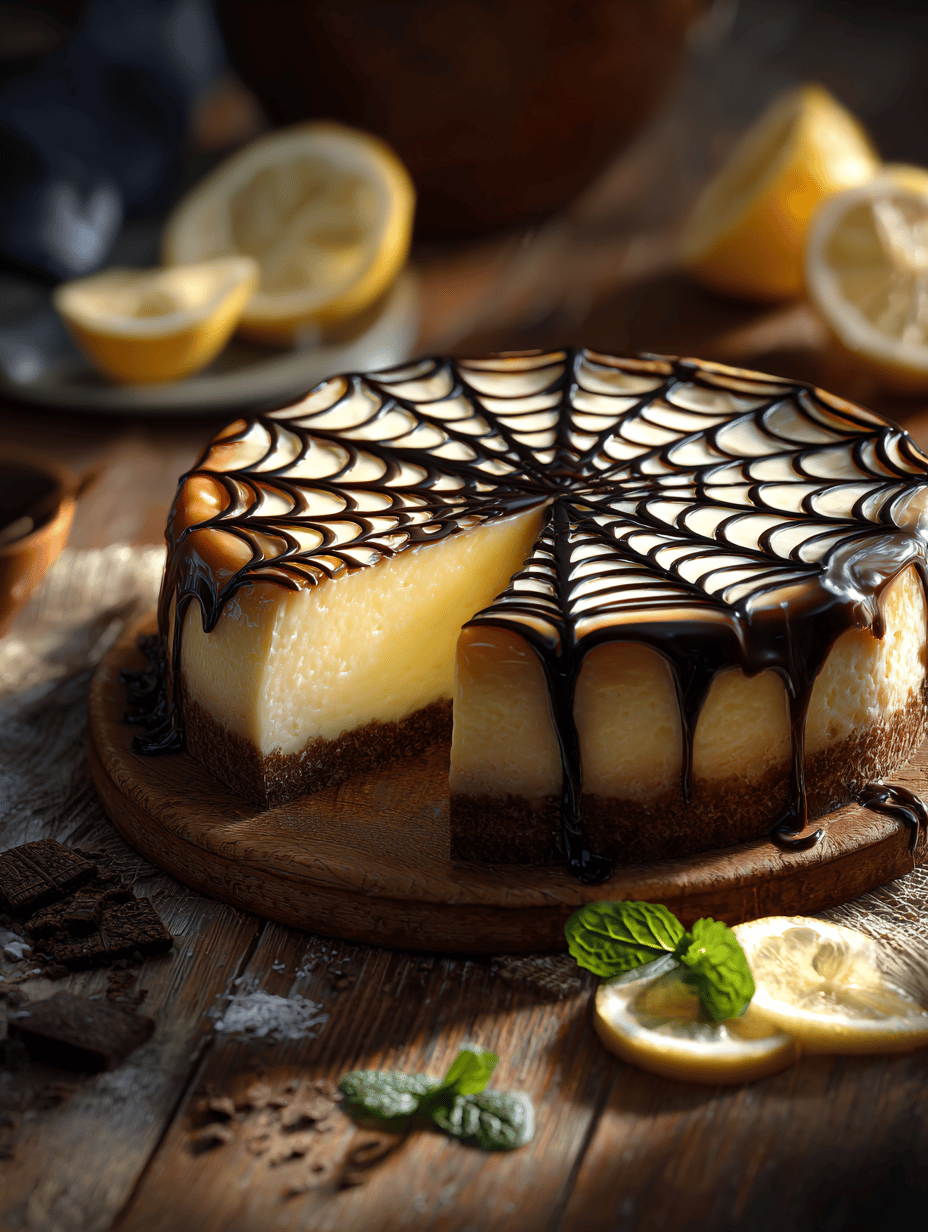
Lemon Spiderweb Cheesecake
Ingredients
Equipment
Method
- Preheat your oven to 160°C (320°F). Line a 23cm (9-inch) springform pan with parchment paper and lightly butter the sides. In a mixing bowl, combine graham cracker crumbs and sugar, then pour in melted butter. Mix until the crumbs are evenly coated and press this mixture into the bottom of the prepared pan. Bake for 10 minutes until golden, then set aside to cool.
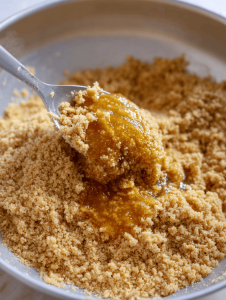
- In a large mixing bowl, beat softened cream cheese with an electric mixer until smooth and creamy, about 2-3 minutes. Add sugar and continue beating until well combined and fluffy.
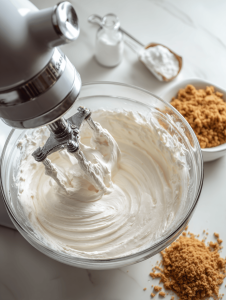
- One at a time, beat in the eggs, mixing just until combined after each addition. Then stir in lemon juice and lemon zest until the mixture is bright and smooth.
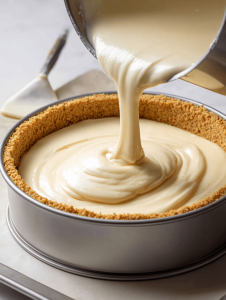
- Pour the filling over the cooled crust, smoothing the top with a spatula. Bake for 50-55 minutes, or until the edges are set but the center still jiggles slightly when gently shaken.
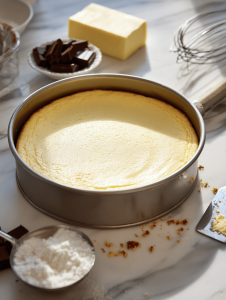
- Remove from the oven and let it cool in the pan for about 30 minutes. Then, carefully transfer to the fridge and chill for at least 4 hours, preferably overnight, until fully set.
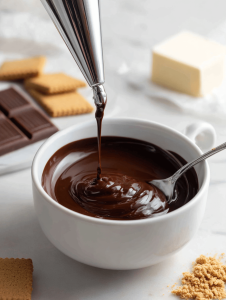
- Once chilled, spread sour cream or whipped cream in concentric circles on the surface of the cheesecake. Use a toothpick or skewer to drag from the center outward, creating a web pattern. Repeat around the surface until the web is complete.
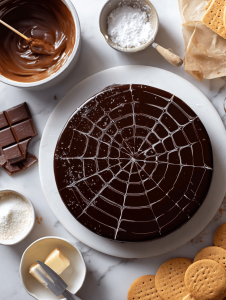
- Chill the decorated cheesecake for another 30 minutes to help the web set and hold its shape. Slice with a sharp knife and serve to enjoy the bright, creamy, and visually stunning dessert.
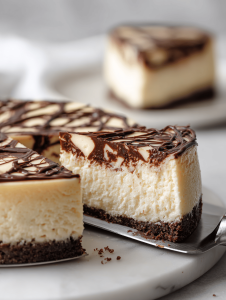
Leave a Reply